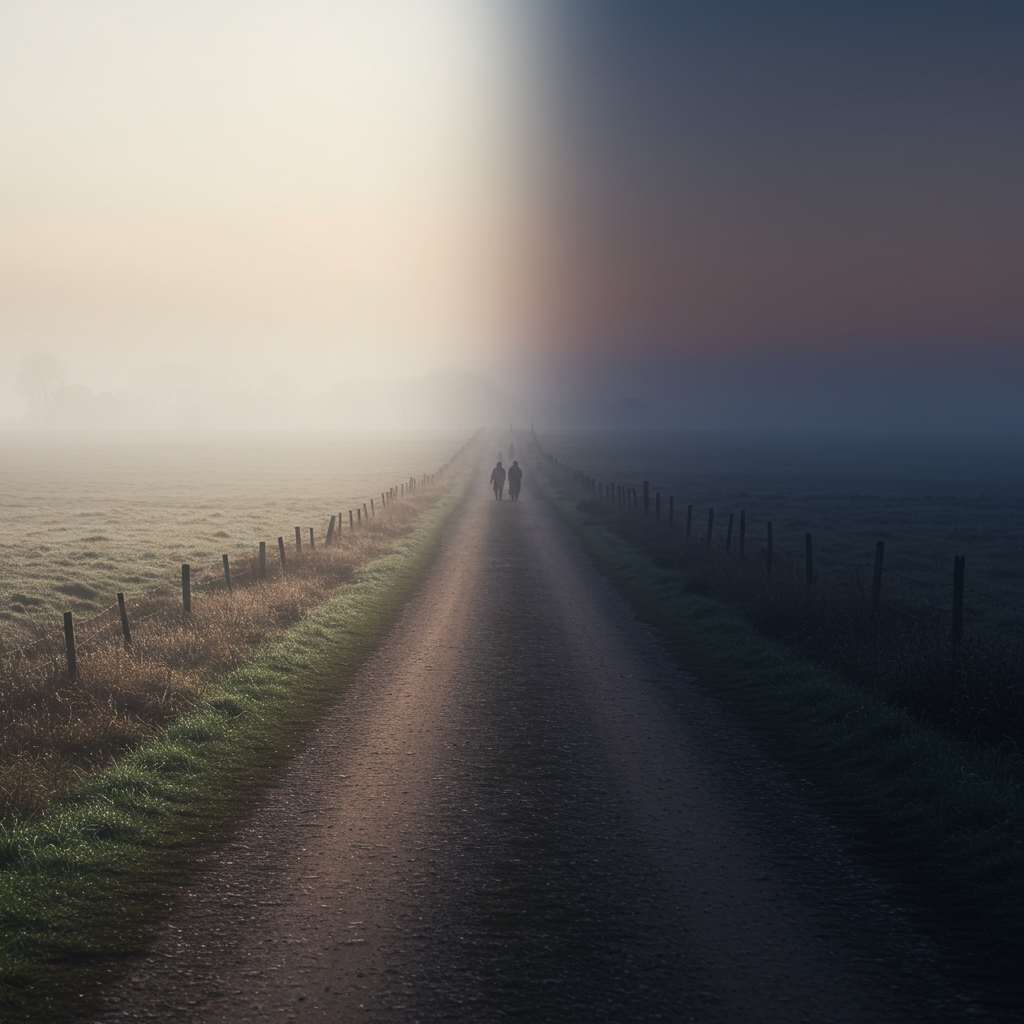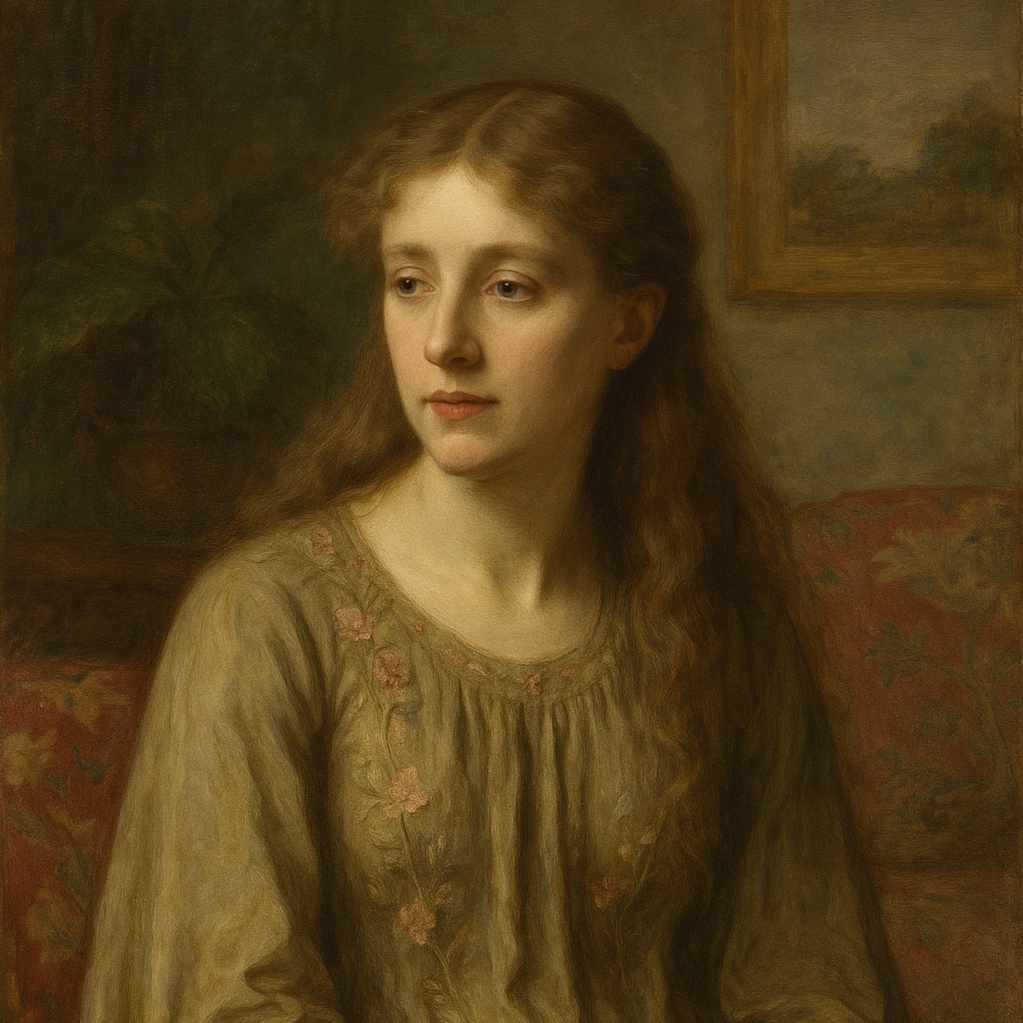The Road Leading Nowhere
A. Mary F. Robinson
1857 to 1944

The road leading nowhere
Is bright in the morn;
We troop it and foot it
By thicket and thorn.
With fewer companions
We pace it at even;
The road leading nowhere
Is pleasant and even.
But oh! there's an hour
That is fatal and still;
'Tis the halt after noon
At the top of the hill.
'Tis the look of the road
As it slips out of sight;
'Tis the flight of the day
And the dread of the night.
A. Mary F. Robinson's The Road Leading Nowhere
A. Mary F. Robinson’s The Road Leading Nowhere is a deceptively simple poem that encapsulates profound existential musings within its brief, lyrical structure. Written in the late 19th century, the poem reflects the transitional period between Victorian certainty and modernist disillusionment, embodying a quiet but piercing meditation on life’s transience, companionship, and the inevitability of decline. Through its evocative imagery, shifting tonalities, and subtle structural progression, the poem invites readers to contemplate the paradoxical beauty and dread embedded in life’s journey.
This essay will explore the poem’s historical and cultural context, its use of literary devices, its thematic preoccupations, and its emotional resonance. Additionally, we will consider Robinson’s biographical influences and situate the poem within broader philosophical and literary traditions to illuminate its enduring significance.
Historical and Cultural Context
A. Mary F. Robinson (1857–1944) was a British poet and scholar who moved in literary circles that included figures such as Robert Browning and Vernon Lee. Her work straddles the late Victorian and early modernist periods, a time marked by growing skepticism toward religious certainty and an increasing preoccupation with existential questions. The late 19th century saw the rise of aestheticism, decadence, and early existential thought—movements that often explored themes of impermanence, beauty in decay, and the futility of human striving.
The Road Leading Nowhere resonates with these concerns. The poem’s title alone suggests an ambivalence toward progress, a theme that would later dominate modernist literature. Unlike the Victorian emphasis on moral and social advancement, Robinson’s poem presents life’s journey as one without a clear destination, emphasizing instead the fleeting pleasures and inevitable solitude of existence.
Literary Devices and Structure
Robinson employs a range of literary devices to convey the poem’s meditative quality. The most striking is her use of imagery, which evolves from brightness and companionship to darkness and isolation. The morning road is "bright," trodden by a group ("we troop it and foot it"), suggesting camaraderie and vitality. By evening, the companions have dwindled, and the road, though still "pleasant," carries a quieter, more subdued energy. The poem’s final stanza introduces a "fatal and still" hour—the moment of reckoning when the road "slips out of sight," and the speaker confronts the "dread of the night." This progression mirrors the arc of human life: from youthful vigor, through gradual decline, to the inevitable confrontation with mortality.
Another key device is paradox, particularly in the juxtaposition of the road’s pleasantness with its ultimate futility. The road "leading nowhere" is not initially framed as tragic; in fact, it is "bright" and "pleasant." Only in the final stanza does the existential weight of the journey become apparent. This tension between enjoyment and dread reflects a philosophical stance reminiscent of Ecclesiastes ("vanity of vanities") or the carpe diem tradition—acknowledging life’s fleeting joys while remaining acutely aware of their impermanence.
The poem’s temporal structure is also significant. It moves through three distinct phases: morning, evening, and the ominous "halt after noon." This tripartite division suggests the stages of life (youth, middle age, and decline) while also evoking the classical ubi sunt motif—a meditation on the passage of time and the loss of what once was. The "top of the hill" serves as a symbolic tipping point, where the speaker glimpses the road’s disappearance, much like the moment in life when one realizes that the path ahead is no longer expansive but narrowing toward an end.
Themes: Transience, Companionship, and Existential Dread
The poem’s central theme is transience—the ephemeral nature of life’s journey. Unlike traditional allegories of life as a pilgrimage with a divine endpoint, Robinson’s road "leading nowhere" resists teleology. This aligns with the late-Victorian erosion of faith in progress, a sentiment that would later be amplified in modernist works like T.S. Eliot’s The Waste Land or the existentialist writings of Camus and Sartre.
Companionship is another crucial theme. The morning’s communal journey ("we troop it and foot it") contrasts sharply with the evening’s solitude ("with fewer companions"). The gradual attrition of fellow travelers mirrors the way life strips away relationships through time, circumstance, or death. The poem’s emotional weight lies in this quiet acknowledgment of isolation—a theme Robinson revisits in other works, such as her Collected Poems, where she often explores melancholy and longing.
Finally, the poem grapples with existential dread, particularly in the final stanza. The "fatal and still" hour is not one of action but of realization—the moment when the traveler sees the road’s disappearance and feels the "dread of the night." This evokes Heidegger’s concept of Angst, the profound anxiety that arises when one confronts the void. Unlike the fear of a specific threat, this dread is formless, tied to the inevitability of the unknown. Robinson’s phrasing—"the flight of the day"—suggests both the swift passage of time and the helplessness of human beings in its face.
Comparative Analysis: Robinson and the Memento Mori Tradition
Robinson’s poem can be fruitfully compared to other meditations on mortality, particularly the memento mori tradition in poetry. Like John Keats’ Ode to a Nightingale—which contrasts the immortal beauty of art with the poet’s own mortality—The Road Leading Nowhere juxtaposes life’s fleeting pleasures with its inexorable end. However, while Keats finds solace in art’s permanence, Robinson offers no such consolation. Her road does not lead to artistic immortality or spiritual transcendence; it simply fades away.
A closer parallel might be Thomas Hardy’s The Darkling Thrush, where the bleak winter landscape mirrors the speaker’s despair, only to be momentarily challenged by the thrush’s song. Robinson’s poem, however, lacks even this glimmer of hope. The "dread of the night" is absolute, suggesting a more austere, almost Schopenhauerian view of existence as fundamentally fraught with suffering.
Biographical Insights: Robinson’s Personal Melancholy
Robinson’s own life may have influenced the poem’s tone. Though she achieved literary success, her personal life was marked by loss, including the early death of her father and her later struggles with depression. Her poetry often reflects a preoccupation with solitude and impermanence, themes that resonate deeply in The Road Leading Nowhere. Additionally, her scholarly work on classical literature (she translated Euripides) may have informed the poem’s fatalistic undertones, reminiscent of Greek tragedy’s inexorable fate.
Philosophical Perspectives: Existentialism and the Absurd
The poem anticipates existentialist thought, particularly Camus’ The Myth of Sisyphus, which argues that life’s meaning is derived not from a predetermined destination but from the act of persistence itself. Robinson’s road, though leading "nowhere," is still "pleasant" for a time—suggesting that the journey’s value lies in the experience rather than the endpoint. However, the poem’s final stanza complicates this reading, as the "dread of the night" implies an unresolved tension between acceptance and despair.
Emotional Impact and Conclusion
What makes The Road Leading Nowhere so affecting is its restraint. Robinson does not indulge in melodrama; instead, she captures the quiet, almost mundane realization of life’s fleetingness. The poem’s power lies in its universality—every reader, at some point, confronts the "top of the hill" moment, where the path ahead no longer promises adventure but only decline.
In its brevity, the poem achieves a rare emotional depth, blending melancholy with a subdued appreciation for life’s ephemeral beauty. It is a poem that lingers, much like the road itself—bright in memory, yet slipping inevitably into darkness. For modern readers, it serves as both a meditation and a warning: to walk the road with awareness, knowing that its very impermanence is what makes it precious.
In the end, Robinson’s The Road Leading Nowhere is not a nihilistic dismissal of life but a poignant acknowledgment of its fragility—a reminder to tread lightly, cherish companionship while it lasts, and, perhaps, find solace in the fact that all travelers, sooner or later, must face the same silent hour at the top of the hill.
This text was generated by AI and is for reference only. Learn more
Want to join the discussion? Reopen or create a unique username to comment. No personal details required!



Comments
What a brilliant performance to a brilliant poem!
The fatal hour at the top of the hill is an inevitable encounter in life. Everything would fall still, and in that stillness, we would realize that we are leaving behind a greater void than the one we are about to enter.
Also, I want to take your attention to another Mary Robinson (1757-1800). She also wrote beautifully. Her lyrical tales would do good for a musical setting.